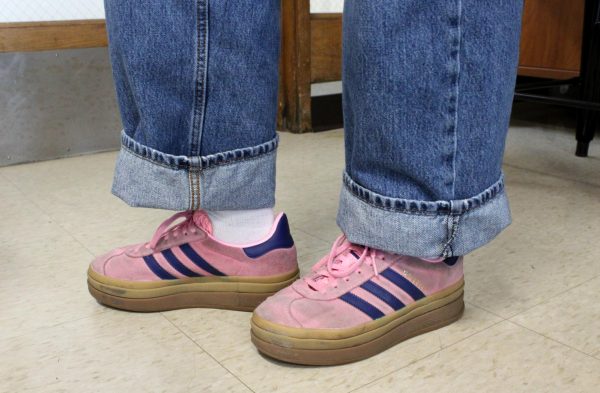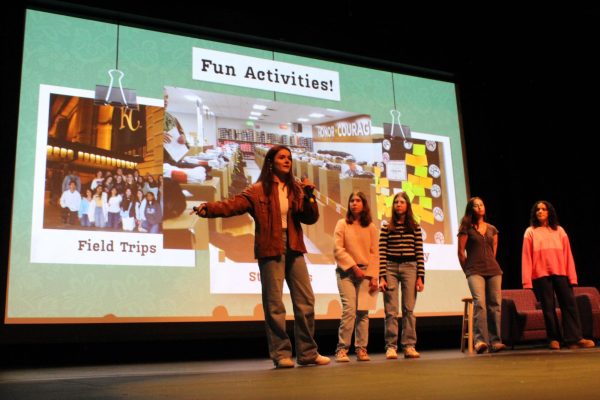Setsubun: The Bean-Throwing Festival of Japan
Many people celebrate Setsubun by wearing Oni (demon) masks and putting dried soybeans in wooden sake boxes called Asakemasu.
As winter is slowly melting away, it finally feels like spring has started to emerge in Libertyville. Spring officially starts at the end of this month, on March 30. However, for countries following the lunar calendar, spring has already started. In Japan, to kick spring off, an annual celebration called Setsubun takes place in homes and temples all over the country. Setsubun literally translates to “seasonal division,” and although it is not a national holiday, this festival marking the end of winter is celebrated by Japanese people far and wide.
The End of Winter, the Start of Spring
Held on either Feb. 2, 3 or 4, Setsubun is a festival that celebrates the beginning of spring and the conclusion of winter. For many centuries, Japanese people have been performing rituals in order to chase away evil spirits at the start of spring.
According to Japan Guide, a website that provides information on traveling in Japan, around the 13th century, it became a custom to drive away evil spirits with the strong smell of burning dried sardine heads, the smoke of burning wood and the noise of drums. While this custom is not popular anymore, a few people still decorate their house entrances with fish heads and holy tree leaves in order to deter evil spirits from entering.
In modern times, the most popular ritual during Setsubun is called Mame-maki. Mame-maki can be translated as a scattering of beans and is the most common celebration during Setsubun.
Throwing and Eating Soybeans
The bean throwing tradition during Setsubun first emerged in the Muromachi period (1337-1573). In Japanese culture, beans represent vitality and good luck. Therefore, according to the Shinto religion, soybeans symbolically purify the home and drive away evil spirits that bring misfortune and bad health.
The phrase mame-maki itself is a play on words. The pronunciation of the word beans, (mame), is similar to the word for demon eyes (mame). So mame-maki has a similar sound to destroying demons, or mametsu.
Although the celebration varies from region to region and family to family, mame-maki involves throwing roasted soybeans either around the
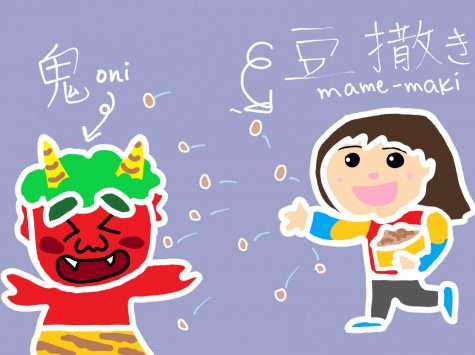
house or at a temple or shrine. The beans are usually thrown from wooden sake (rice wine) boxes called asakemasu. Those throwing the beans shout phrases such as, “Oni wa soto- Fuku wa uchi!”(“demons out, happiness in!”), or “Senshu banzei fuku wa uchi” (a buddhist prayer for eternal good luck), or “Fuku wa uchi, oni wa uchi, akuma wa soto” (“happiness in, demons in, bad spirits out!”).
While many local shrines host Setsubun events with smaller audiences, some public Setsubun mame-maki celebrations at temples and shrines have been known to attract up to tens of thousands of people, with cameos from celebrities.
Naritasan Shinshoji, a famous temple in Narita City, Chiba, is one of the most popular sites of bean throwing. As stated by a news article on Nippon.com, the 2020 Setsubun celebration at Naritasan Shinshoji featured various actors, professional sumo wrestlers and other prominent figures wearing traditional clothing while throwing soybeans into a crowd of thousands.
In respect to household celebrations of Setsubun, there are many variations of mame-maki. In some regions of Japan, it is common for the head of the household to throw beans outside the front door chanting, “Oni wa soto- Fuku wa uchi.” In families with younger children, the father may dress up as an Oni, or demon, and the children will throw beans at him, yelling the Mame-maki chant.
Alyssa Wells, a senior, has celebrated Setsubun by participating in mame-maki with her family in Libertyville since she was little.
“Either my mom or dad would put on a mask, and after they went outside, we would throw the beans at them and we would also throw beans inside our house,” she said.
After the bean throwing is over, everyone usually eats a number of beans corresponding to their age, or their age plus one. This ritual ensures good luck for the next year.
Despite the fact that the mame-maki tradition is for everyone, it is widely enjoyed by younger children, and many kindergartens and preschools in Japan hold mame-maki events.
Senior Caitlin Gromacki remembers participating in Mame-maki as a young child in Japan:
“A distinct memory I have is celebrating it at my grandparents’ house and throwing soybeans in my living room,” Gromacki said. “I also had fun celebrating it when I went to kindergarten in Japan.”
Lucky Sushi Rolls
Besides the beloved soybeans in Japanese culture, another popular food to eat during Setsubun is a sushi roll called ehomaki. Ehomaki literally translates to “lucky direction roll”, and consists of vinegary rice wrapped in seaweed with various fillings.
Traditionally, everyone faces the lucky direction
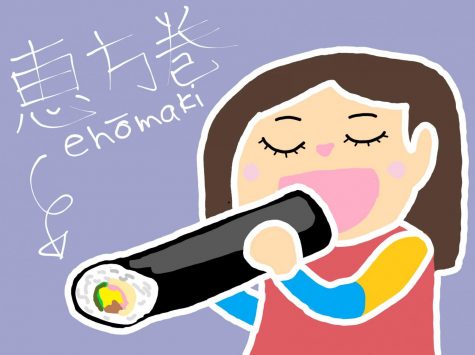
(eho) of the year, and eats the entire roll of sushi in silence to bring good luck. The lucky direction is based on the Chinese zodiac, and this year it landed on the south-southeast direction.
According to the online newspaper Japan Today, ehomaki originated from the city of Osaka in Japan and was originally celebrated in the Kansai (the southern region of Japan’s main island Honshu) area.
Nowadays, as ehomaki has gained nationwide popularity in Japan, around Setsubun, vast arrays of convenience stores and restaurants also serve ehomaki. Becoming more and more commercialized, some restaurants have as gone as far as advertising cake rolls as ehomaki because of their resemblance to the long rolls of sushi.
Japanese Culture in Illinois
As popular as Setsubun is in Japan, public celebrations of Setsubun, as well as Japanese holidays in general, are very sparse in Illinois. According to Data USA, as of 2020, only around 6% of Illinois residents are Asians, and an even slimmer margin of them are Japanese.
Wells and her family celebrate more Japanese holidays than American holidays, and she is aware that she is very much in the minority when it comes to being influenced by Japanese culture in Libertyville. However, she takes pride in being Japanese and in being different.
“Knowing we’re among the very few Japanese families in Libertyville, I feel Japanese culture brings my family together in a really special, unique way,” Wells expressed.
For those who wish to experience and learn about Japanese culture, there are various organizations dedicated to making Japanese culture available to people from any background.
Namely, Japan House at the University of Illinois Urbana-Champaign is dedicated to sharing Japanese arts and culture. Although they are closed to in-person activities because of Covid-19 currently, Japan House holds various events displaying Japanese arts and culture, such as tea ceremonies, during a normal year. Setsubun events have been held at Japan House in the past.
Diana Liao, the education associate at Japan House, explained that the mission of the Japan House is as a center for learning that brings people together.
“Given that we’re not like an Asian American cultural center, the Japan House is not just meant for Japanese people,” Liao articulated. “The purpose of our building and what we do is to teach non-Japanese people about Japanese arts and culture.”
Additionally, the Japanese American Services Committee, based in Chicago, holds classes, cultural programs, demonstrations and more to help community members experience Japanese American history and culture. In early February, a free Zoom demonstration on how to make ehomaki was taught by a local Chicago sushi chef.
Sumei Barton, a sensei at Japan House who leads the tea ceremonies and heads other events, hopes that people from all backgrounds seize the opportunities to learn about other cultures.
“Setsubun is not widely known by many Americans,” Barton expressed. “But it offers a window into the Japanese experience. People may find that they have more connections to Japanese culture than they think if they just give it a chance.”



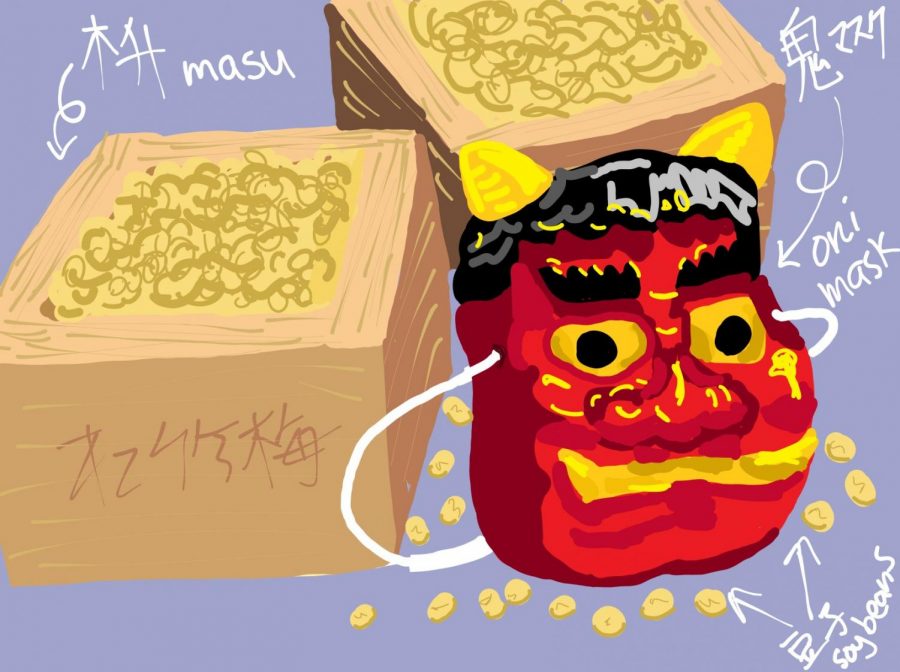


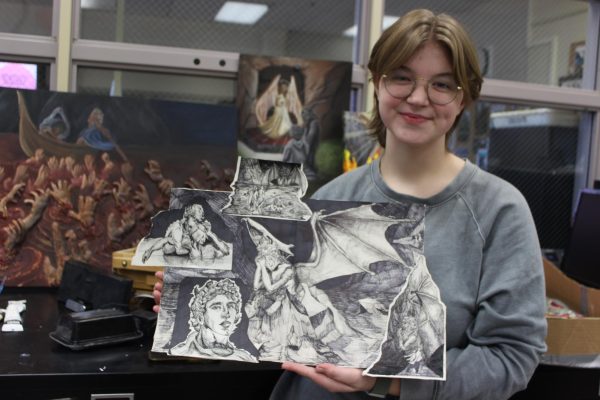
![Senior River Thompson joins the Jazz Ensemble by singing “That Old Black Magic” by Mercer and Arlen Arr. Mark Taylor, along with senior Annie Brody on guitar and junior Thomas Teixeira on bass, earning big applause. “[The concert had] great energy because it's the last [jazz concert] of the year,” Brody said.](https://www.lhsdoi.com/wp-content/uploads/2025/04/Eight-That-Old-Black-Magic-600x400.jpg)
![Mr. Abullh Ali, manager/assistant, helps open Queen Yemeni Coffee in downtown Libertyville at 606 North Milwaukee Ave. With the help of employees such as manager and LHS senior Yousef Taha, they are able to bring the Yemeni and Ethiopian culture to Libertyville by using their Queen spices, cinnamon and cardamom in their drinks such as Adani Chai, which is inspired by Sheda, the Queen of Yemen and Ethiopia. “The history of our coffee [is] a long history and we believe that Yemen and Ethiopia started the coffee and we are bringing something unique to the community,” Mr. Ali said.](https://www.lhsdoi.com/wp-content/uploads/2025/04/Photo-1-600x400.jpg)
